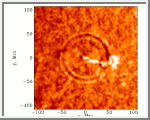|
COMETS EARTH JUPITER KUIPER BELT MARS MERCURY METEORITES NEPTUNE OORT CLOUD PLUTO SATURN SOLAR SYSTEM SPACE SUN URANUS VENUS ORDER PRINTS
PHOTO CATEGORIES SCIENCEVIEWS AMERICAN INDIAN AMPHIBIANS BIRDS BUGS FINE ART FOSSILS THE ISLANDS HISTORICAL PHOTOS MAMMALS OTHER PARKS PLANTS RELIGIOUS REPTILES SCIENCEVIEWS PRINTS
|
Related Document
Download Options
This is an image taken from a movie of the July 9, 1996 solar quake The images were made using the Michelson Doppler Imager onboard the Solar and Heliospheric Observatory (SOHO) spacecraft, a joint European Space Agency/NASA project. The white, feathery object in the center is the solar flare that caused the quake. A solar flare is an explosion in the atmosphere of the Sun, caused by the tearing and reconnection of strong magnetic fields. Although moderate in size, this flare released an enormous amount of energy. The energy released is equal to completely covering the Earth's continents with a yard of dynamite and detonating it all at once. Some of this energy was transferred to the solar surface by high speed electrons traveling within magnetic flux tubes, invisible tubes of magnetic energy. They produced X-rays, microwaves and shock waves that heated the solar surface. These shock waves are the solar quake, and can be seen as concentric rings spreading outward from beneath the flare, much like ripples spreading from a rock dropped into a pool of water. The flare-generated solar quake contained about 40,000 times the energy released in the great earthquake that devastated San Francisco in 1906. The amount of energy released was enough to power the United States for 20 years at its current level of consumption. (Courtesy Dr. Alexander Kosovichev/Stanford University, the European Space Agency, and NASA) |
